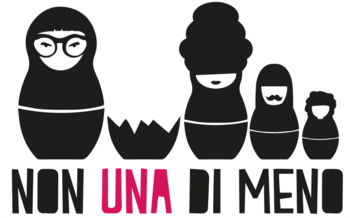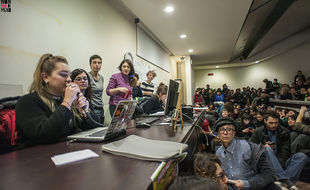Women in Italy only got the right to vote in 1945, over 20 years later than America. Married women were the property of their husbands until 1919. The fascist government during the Second World War further emphasized the woman's role as a bearer of children for the man, and as someone who tends to the home. Though women have gained a great deal of autonomy since then, the members of Non Una Di Meno believe that with the growing neoliberal society, women are losing some of the rights they fought so hard for over the past decades. In Italy, 1 in 3 women has suffered from some kind of violence in her life. Only 1 in 7 gynecologists will perform an abortion. 1 woman is killed every 3 days by a man/men of whom she is familiar. However, even with stricter punitive laws for those responsible, the problem has not improved. This is because it is a structural problem engrained in society, and this is what Non Una Di Meno grew out of, in order to combat it. They are working to change how we think, see, and talk about our world. These actions are so habitual and so established in society that it is hard to discern them as unnatural. Non Una Di Meno is not the first group of its kind; it is in fact quite young. Differenza Donna is a group that was founded in 1989 and has been working to overcome gender-based violence. Differenza Donna is a part of WAVE (Women Against Violence Europe), a European network of 46 countries fighting against gender-based violence. With this international support, they helped found D.i.Re, an Italian network of women's shelters. The organization Sommosse was founded under similar circumstances to Non Una di Meno's, but almost 10 years earlier. After a woman was assaulted and killed in Rome, this group emerged to join in the struggle against gender violence. So though Non Una di Meno is not the only organization with these aims, it has been instrumental in gaining international attention and due to its support from, and its connection to, many other movements, it has been more successful.
Non Una Di Meno was created in 2015 as a response to the brutal murder of a young woman by her ex-boyfriend. The movement was inspired by Ni Una Menos, which began as a response to a similar murder in Argentina. It was started by the leaders of three pre-existing groups, Io Decido, a pro-choice group, UDI – Unione donne in Italia, a group dating back to the 1940s which focuses on achieving equal rights for women in the law, and D.i.Re – Donne In Rete contro la violenza, an Italian network of anti-violence centers and women's homes. These three groups came together, along with hundreds of their volunteers, to create Non Una Di Meno, when they realized that all their causes were interconnected within a broader feminist movement. They understood that it is not sufficient to simply change one legislation or create another center, but that Italian women need to stand in solidarity to try and tackle the institutionally patriarchal Italian society. On November 26th, 2016, they had their first big demonstration in Rome, which gathered over 200,000 women, men, and children, from all over Italy. Since then, the group has continued to grow, receiving funding through donations, and through the three pre-existing groups that founded it, and that they continue to work closely with.
Non Una Di Meno is an anti-fascist, feminist group. Their ideological composition is important because Italy has a history of very right wing parties in power, and the legislation reflects this. The group is working to push back against fascism, and the aspects that come with a conservative government, like sexism and racism. The group is interventionist, meaning they don't want a dissolution of the government, but want to work with them to create new legislation. Though more than this, they value resistance and oppose the societal sexist norms. As the group is so large and consist of members all across Italy, there are most likely ideological splits among individuals, but all are feminist. The group does not delineate any distinction on their ideological position in relation to capitalism, although their emphasis on publicly funded women's shelters and healthcare suggest socialist tendencies.
Non Una Di Meno is a network composed of "nodes", as they are described by group members. Every city assembly constitutes a "node" in the network. The city assemblies are composed of associations, collectives, and individuals. They meet annually or bi-annually and put together plans, like the National Anti-Violence Plan put together after the first march on Nov 26, 2016, and use those to lobby. Anyone can attend the assemblies and voice their opinion. There is not a specific structure to the leadership of the group, however there is distinction between women who lead and organize the assemblies, centers, marches, donations, social media, etc. and those who simply participate. The leaders in these situations will be leaders from other established groups, or those who are more involved and thus having a higher position in Non Una di Meno. There is no president or traditional group leader distinction, but there is the possibility of being more involved in the organization of the group, or simply joining a demonstration or attending an assembly. Anyone who wants to be more involved and have more responsibility within the group can; there is no election of an exec board or president, for example. The group is made up of mostly women, but there are men who participate, and the group is open to anyone who "wants to fight against masculine violence towards women and all types of gender violence." Non Una Di Meno is made up of people of various classes, races, sexualities, and ages, and they emphasize this diversity as key to the group. They maintain that gaining rights for white, affluent, women does not contribute to creating a long-term solution to institutionalized gender violence.


